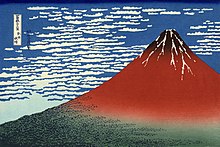Continuous tone image

A continuous-tone image is one in which each color at any point in the image can transition smoothly between shades, rather than being represented by discrete elements such as halftones or pixels.[1]

Examples of continuous-tone images are natural phenomena,[2] images produced with dye-based processes,[3] images produced with certain analog printmaking processes (intaglio, block printing, stone lithography),[4] and paintings. Halftone prints (as produced with inkjet and offset printers), traditional film, and digital screens are not truly continuous-tone since they rely on discrete elements (halftones, grains, or pixels) to create an image.[5] However, the term applies when the appearance is so smooth that the breaks or gaps between tonal values are imperceptible.[6]
TV, computer and phone displays are effectively continuous. Purely analog video signals can provide infinite tone variations according to their gamut.
See also
[edit]References
[edit]- ^ McCulloch, Joseph (2008). "Understanding Continuous Tone and Halftone Printing". Printmaking Today. Vol. 20, no. 4. pp. 34–40.
- ^ Elkins, James (2001). Why Art Cannot Be Taught: A Handbook for Art Students. University of Illinois Press.
- ^ Sweeney, Megan (2012). "Dye Sublimation: An Overview". Journal of Imaging Science and Technology. 56 (2): 220–226.
- ^ Anderson, Katherine (2015). The Printmaking Primer: A Beginner's Guide to Printmaking Techniques. RIT Press.
- ^ McCullough, Michael (2018). Digital Media: A Practical Guide for Artists and Designers. Wiley.
- ^ Stork, David (2013). The Science of Image Processing: An Overview. Springer.
